Lube-Tips
 Use a Camera for Better Oil Analysis
Use a Camera for Better Oil Analysis
Put your cellphone camera to good use by taking a photograph of an oil sample (if using a transparent sample bottle) and storing the image in a trending software for comparative purposes. Record a new oil sample and use this as a baseline. Set the bottle against a white background, like a sheet of paper, to maintain a consistent color comparison.
You can also use your camera in other ways, such as to record images of the machine and sampling point as a means of identifying them in the oftware or to record abnormalities such as excessive leakages for easy location by mechanics. Pictures are immediate and speak volumes, so use them to good effect in reports and trending software.
Advice for Replacing Brake Fluid
Brake fluid is highly hygroscopic, which means it absorbs moisture from the atmosphere. Apart from the obvious corrosion potential this presents to the master and slave cylinders, it also degrades the fluid’s high-temperature performance. This results in the fluid boiling at a lower temperature, leading to the loss of fluid power when pressing the brake pedal. Follow the manufacturer’s recommendations and change the fluid regularly. Synthetic silicon-based brake fluid is more expensive but does not need to be replaced as often. As custom and classic car owners know, it also does not damage the paint work.
How to Identify Suction Line Leaks
Suction line leaks can cause air entrainment and lead to problems such as excessive aeration, air lock, pump cavitation, poor lubrication and premature oil degradation. However, a pinhole-sized suction line leak can be hard to find. Using a small amount of shaving foam sprayed over the suspected leak area can indicate the source of the problem, as the foam will be drawn into the line. This method should not be used for large leaks, and care should be taken to not use too much soap, as this could contaminate the lube and result in foaming, aeration problems and poor demulsibility.
Tips for Lifting and Carrying Oil Drums
Always ensure the correct lifting and carrying equipment is available. Avoid lowering oil drums onto any small, sharp objects. These objects can pierce an oil drum and cause leakage, which if unnoticed, could pose a safety risk to the person moving the drum as well as other colleagues.
Did You Know?
Additional tips can be found in our Lube-Tips email newsletter. To receive the Lube-Tips newsletter, subscribe now at machinerylubricationindia.com
Have some tips?
If you have a tip to share, email it to admin@machinerylubricationindia.com
